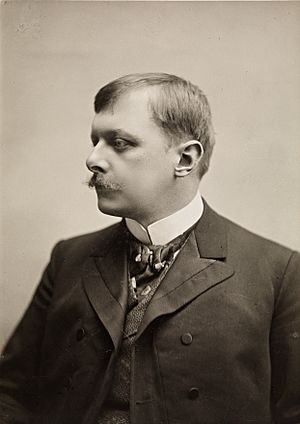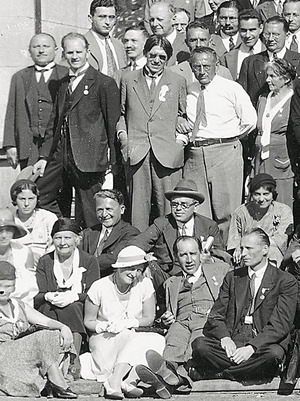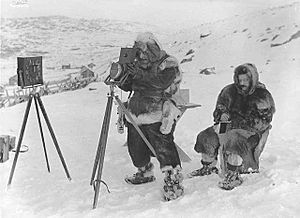Carl Størmer facts for kids
Quick facts for kids
Carl Størmer
|
|
|---|---|
 |
|
| Born |
Fredrik Carl Mülertz Størmer
3 September 1874 |
| Died | 13 August 1957 (aged 82) |
| Nationality | Norwegian |
| Alma mater | University of Oslo |
| Known for | number theory aurorae |
| Awards |
|
| Scientific career | |
| Fields | |
Fredrik Carl Mülertz Størmer (born September 3, 1874 – died August 13, 1957) was a famous Norwegian mathematician and astrophysicist. He made important discoveries in two main areas. In mathematics, he was known for his work with number theory. This included calculating the number π and developing Størmer's theorem.
In physics, he studied how tiny charged particles move in Earth's magnetosphere. He also researched how aurorae (like the Northern Lights) are formed. He wrote a book about these topics called From the Depths of Space to the Heart of the Atom. Størmer worked for many years as a professor at the University of Oslo in Norway. A crater on the far side of the Moon is named after him.
Contents
Carl Størmer's Life and Work
Carl Størmer was born on September 3, 1874, in Skien, Norway. He was the only child of Georg Ludvig Størmer, a pharmacist, and Elisabeth Amalie Johanne Henriette Mülertz. His uncle, Henrik Christian Fredrik Størmer, was a well-known inventor.
Størmer studied mathematics at the Royal Frederick University in Kristiania (now Oslo) from 1892 to 1897. He then continued his studies in Paris from 1898 to 1900. In 1903, he became a professor of mathematics back in Kristiania. He held this important job for 43 years! After becoming a professor, he started using the shorter name, Carl Størmer, for his writings.
He was also the first president of the Norwegian Mathematical Society, which started in 1918. Størmer often attended big math conferences. He even led the International Congress of Mathematicians in Oslo in 1936. He also worked with the Institute of Theoretical Astrophysics at the University of Oslo. Carl Størmer passed away on August 13, 1957.
Besides his scientific work, Størmer enjoyed taking pictures of people on the street. When he was almost 70, he even had an exhibition of his photos. He captured famous people like Henrik Ibsen walking in Oslo.
In 1900, he married Ada Clauson. They had five children together. Their son, Leif Størmer, became a professor of geology. Carl Størmer's grandson, Erling Størmer, also became a mathematician.
Størmer's Math Discoveries
Carl Størmer's first math paper was published when he was just 18 years old. He worked on complex math problems involving trigonometry. Later, he focused on finding new ways to calculate the number π.
He found many different formulas to represent π. One of his four-term formulas was used in 2002 to calculate π to over a trillion decimal places! This shows how important his work was for fast computer calculations. Størmer also discovered what are now called Størmer numbers, which came from his work on these formulas.
In 1897, Størmer proved an important idea known as Størmer's theorem. This theorem helps us understand certain types of numbers. It shows that for any set of prime numbers, there are only a limited number of pairs of consecutive integers that can be made using only those prime numbers as factors. He also created a way to find all such pairs. This theorem has even been used in understanding music theory.
Størmer also studied other math topics like Lie groups and gamma functions. He helped edit the math works of famous mathematicians Niels Henrik Abel and Sophus Lie after they had passed away.
Studying Space and Aurorae
Carl Størmer became very interested in aurorae (like the Northern Lights) in 1903. He saw Kristian Birkeland's experiments trying to explain them. Størmer wanted to use math to understand how charged particles move when they are affected by Earth's magnetic field.
He published over 48 papers on how these charged particles move. Størmer's math showed that even small changes in how particles approach Earth could lead to the complex shapes of aurorae. He also thought about how particles might get trapped in Earth's magnetic field. His ideas helped explain what we now call the ring current and Van Allen radiation belts, which are areas of trapped particles around Earth.
Størmer didn't just use math; he also took many photographs of aurorae. He set up 20 observatories across Norway to do this. By using a method called triangulation, he could measure how high the aurorae were. He found that they are usually about 100 kilometers (about 62 miles) above the ground. In 1926, he discovered "solar-illuminated aurorae." These can appear at twilight when the sun lights up the very top parts of an aurora. These special aurorae can be as high as 1,000 kilometers (about 620 miles) up!
Størmer wrote a book called From the Depths of Space to the Heart of the Atom. It was so important that it was translated into five languages. He also wrote The Polar Aurora in 1955. This book combined his experiments and his math models of aurorae. Many scientists considered him the top expert on aurorae.
Størmer also investigated other space phenomena. These included changes in Earth's magnetic field, strange echoes in radio signals, and beautiful nacreous clouds. He also studied zodiacal light, meteor trails, the solar corona, and cosmic rays.
Awards and Special Honors
Carl Størmer received many awards and honors for his amazing work. He was a member of the Royal Society and the French Academy of Sciences. He also joined the Norwegian Academy of Science and Letters in 1900.
He received honorary degrees from important universities like Oxford University, the University of Copenhagen, and the Sorbonne. In 1922, he was given the Janssen Medal by the French Academy.
Størmer was invited to speak at the International Congress of Mathematicians three times. This is a very high honor for a mathematician. In 1971, a crater on the far side of the Moon was named after him.
He also received medals from Norway. In 1902, he was given King Oscar II's Medal of Merit in gold. He was also made a Knight, First Order of the Order of St. Olav in 1939. In 1954, he was given the highest rank, Grand Cross of the Order of St. Olav.



